UK Events Industry Value, influence, and more
This month’s headlines underline the growing economic and political significance of the UK events sector, from record-breaking industry value and global confidence to renewed focus...

Last month, Paula Calton, Business Director for EDGE Venues, headed out to Seville to experience the delights of what Seville has to offer. During the trip, Paula visited several hotels and has shared her top tips when considering these venues for meetings and events.
Located in the south west of the Iberian Peninsula, Seville is Spain’s 3rd urban tourist destination which boasts an immense historical, monumental and cultural heritage. The city has a population of just over 700,000 making it the 4th largest city in Spain after Barcelona, Madrid & Valencia.
Seville is the capital of southern Spain’s Andalusia region. It’s famous for flamenco dancing, particularly in its Triana neighbourhood. Major landmarks include the ornate Alcázar castle complex, built during the Moorish Almohad dynasty, and the 18th-century Plaza de Toros de la Maestranza bullring. The Gothic Seville Cathedral is the site of Christopher Columbus’s tomb and a minaret turned bell tower, the Giralda.
Thanks to the city’s modern infrastructure and excellent communications, favourable weather, delicious gastronomy and its hospitable inhabitants Seville is ideal for hosting events and individual tourism. The city of Seville has a wide communications network: Ave, high speed train; San Pablo International Airport; motorways, and a modern fluvial port for the reception of cruises.
Seville has the same time zone as Central Europe (GMT +1). Capitals such as Paris, Amsterdam, Berlin or Stockholm share the same time zone as Seville. This is, for example, 6 hours ahead of Washington, 8 hours behind Beijing, 9 hours behind Tokyo, 10 hours behind Sydney or 4 hours ahead of Rio de Janeiro.
The official currency of Seville is the Euro.

The airport of San Pablo is located ten kilometres northwest of the city of Seville, between the limits of the cities of Seville and Rinconada.
Seville Airport is the sixth busiest inland airport in Spain. It is the main international airport serving Western Andalusia in southern Spain, and neighbouring provinces. The airport has flight connections to 42 destinations around Europe and Northern Africa, and handled 5,108,807 passengers in 2017.
A taxi from the airport to the city centre costs approx. 25 euros.
Seville is significantly cheaper than Barcelona or Madrid for accommodation and venue hire often as much as 50% less depending upon the time of year. Hotel prices change very little throughout the year with the exception of major holidays and festivals when availability is limited, and rates increase.
An average price for a 3-course dinner with wine would be 20 -30 euros per person. Tapas start at 2 euros each, beer at one euro for a caña (small glass – even less in some places), and wine at 2 euros a glass. The more avant-garde tapas bars will charge up to 5 euros for a small dish, but the ingredients and presentation will be correspondingly more sophisticated.
Seville has a total of 9,423 bedrooms and this is increasing.
| Star rating | No of Hotels | No of Rooms |
| 5* | 5 | 707 |
| 4* | 47 | 6161 |
| 3* | 36 | 1906 |
| 2* | 16 | 408 |
| 1* | 12 | 241 |
| Total | 116 | 9423 |
Commissioned by the King of Spain to play host to international dignitaries during the 1929 Exhibition, Hotel Alfonso XIII remains an iconic cultural landmark. Centrally located in the historic quarter of Santa Cruz, it sits next to Reales Alcázares and Seville Cathedral. Following a significant renovation, completed in 2012, the hotel’s distinguished architecture and Moorish detailing have been enriched, showcasing native Andalusian design and heritage.
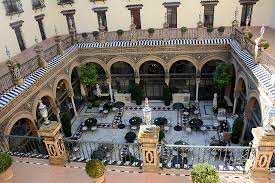
The hotel has 126 guest rooms and 22 suites. There are 9 function rooms four of which have a very individual style and décor and access to outside terraces and the gardens and can accommodate up to 350 delegates. The other five are smaller, plainer spaces but very functional for syndicates. Cocktails, lunches, coffee break etc can be served on the many terraces, in the gardens or around the pool. There is a bar and restaurant on the ground floor and a pool side bar.
The ideal group size for the hotel is 70 -100 rooms depending upon season (between Dec- Feb this could go to 20 rooms and also offer buy outs). This is a stunning property with lots of outside space, a real sense of luxury and ideal location for exploring the city.
The Eurostars Torre Seville opened in June 2018 and occupies the top 19 floors of the Torre Sevilla and at 180.5 meters it is the highest skyscraper in Adalusia. Located next to the Triana district, the hotel is 10 minutes’ walk from the Carthusian Monastery, less than 10 minutes by car from the Science and Technology Park and just 15 minutes from Seville Airport.
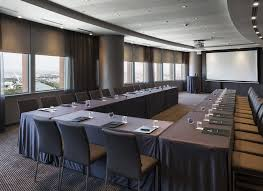
The hotel has 7 rooms and 21 meeting rooms all of which have natural daylight, the latest technology and can accommodate 2-300 delegates. The restaurant is on the 34th Floor and the 37th floor Atalaya terrace cocktail bar provides a great space with 360 degree views and can be privatised for events.
As the hotel is new and has a lot of meeting space there are opportunities for groups to obtain some very favourable rates.
Built in 1761, and originally owned by the Royal Tobacco Factory, Hard Rock Cafe Sevilla’s building retains many elements of the original construction with both its facade and interior having the original architectural features from the 18th century.

The multi-level Cafe includes indoor seating over two floors, an upscale vibrant atrium bar and a Rock Shop. Taking inspiration from local architecture, using traditional Sevillian materials and finishes throughout the design, the highlights are its prominent arches, compelling ceramic tiles and wooden fixtures.
From an intimate unplugged meeting to a full-blown production, Hard Rock’s unique and comprehensive resources allow you to execute corporate meetings & events, convention receptions, incentive rewards or private dining.
ORIO is characterised by a new conceptualisation of the Basque tavern based on an overflowing “pintxos” bar along with a short yet varied menu inspired by the fishing villages in the Basque country. The front of the premises is a spacious pintxo bar opening onto Calle Santo Tomas, with a terrace facing the Archivos de India. The bar itself is on one side, with a very appetising array of Basque style pinxos so typical in Bilbao and San Sebastián, but something of a novelty in Sevilla.
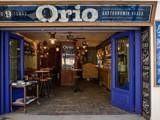
Beyond the bar are two dining rooms leading out to a second terrace on Calle Miguel Mañara, with space for around thirty diners. Decoration is minimalist, but with lots of wood, and a big mural of a fisherman (Orio is the name of a Basque fishing village).
Average price for 2 courses without drink is 30 euros.
Located in the heart of Seville, the Real Alcazar is one of the oldest palaces still in use in the world. The palace has evolved through different stages over time, from the late 11th century to the present day. From its walls we can appreciate the influence of the cultures that have passed through the city.
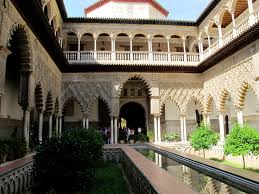
This palace-fortress was commissioned by Abd Al Raman III, it is intricately formed of exquisite rooms decorated with plasterwork, tiling and coffered ceilings, which combine perfectly with the magnificent gardens and use of water to create an unforgettable impression.
Highlights of the palace include the Patio de las Doncellas courtyard, with its beautiful tiled plinths, and the Patio de las Muñecas courtyard, with its fascinating collection of capitals.
The Palace closes for 3 days if the Royal family visit otherwise it opens to the public everyday 9-5. It is worth noting that some of the spaces and terraces are available for hire for private cocktail receptions and/or tours.
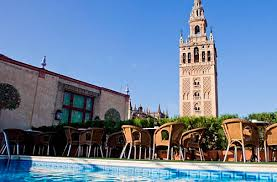
Hotel Doña Maria is a newly refurbished ancient palace situated in the historic centre of Seville at the edge of the Santa Cruz Quarter. With views over the Cathedral and the Giralda from its roof top bar a swimming pool.
This 4 star hotel provides flexible meeting spaces for smaller groups of 10 – 30 delegates , 64 traditionally styled bedrooms a relaxing lounge, cocktail bar and restaurant.
The Cathedral of Seville was constructed on the Great Almohad Mosque. In 1401, the Chapter decided “to build another church so great that there is no other that is equal, so that the authority of Seville and its Church is considered and obeyed as reason commands”.
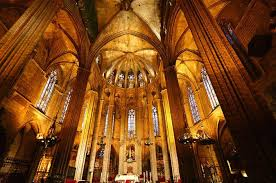
It is the third-largest Cathedral in the world after St Peter’s in the Vatican and St Paul’s in London. The cathedral is impressive and stands in the historical centre of Seville. There are so many incredible details in every corner of this cathedral including the tomb of Christopher Columbus, and you can climb up the bell tower, the views across Seville are unbeatable but be warned there are a lot of steps! The inside has multiple side chapels etc, all beautifully carved and decorated.
The stonework, wood carvings, paintings, silverware and in particular the wonderful organ were quite fantastic. No wonder it is at the top of World Heritage site listings. The Patio de Los Naranjos (orange tree garden) is also very original touch for a church.
Group tours can be arranged.
Metropol Parasol is a wooden structure located in the old quarter of Seville, Spain, that has become the modern symbol of Seville. It was designed by the German architect Jürgen Mayer and completed in April 2011. It is 150 by 70 metres large and about 26 metres high and it claims to be the largest wooden self-sustaining structure in the world.
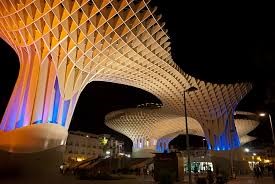
The building is popularly known as “The Mushrooms”. It was built at a cost of 80 million Euros. The structure consists of six parasols in the form of giant mushrooms (“Las setas” in Spanish), whose design is inspired by the vaults of the Cathedral of Seville and the ficus trees in the nearby Plaza de Cristo de Burgos. Metropol Parasol is organized in four levels.
The underground level (Level 0) houses the Antiquarian, where Roman and Moorish remains discovered on site are displayed in a museum. Level 1 (street level) is the Central Market. The roof of Level 1 is the surface of the open-air public plaza, shaded by the wooden parasols above and designed for public events. Levels 2 and 3 are the two stages of the panoramic terraces (including a restaurant), offering one of the best views of the city centre.
There is one space available for private hire for events on level 3 for 150 delegates.
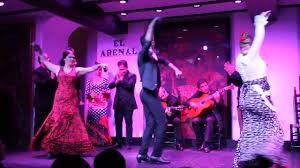
This venue was nominated as the place that showcases the best flamenco show in Seville by the New York Times. The Tablao El Arenal in Seville is the most emblematic flamenco scene in the city. With 40 years of history, in this restaurant you can enjoy the purest and most authentic Flamenco Art.
The restaurant is located in the historical and cultural centre of Seville, in the El Arenal neighbourhood, between the Maestranza de Sevilla bullring and the Maestranza Theatre, a few meters from the Giralda, Seville Cathedral and The Golden Tower.
The restaurant can seat up to 80 and does 2 dinner sittings with a show per night at 7pm and 9.30 and costs 50-70 euros per person for dinner, drinks and show.
Seville is the home of Flamenco and I have never seen anything quite as amazing as the display that I witnessed at Tablao El Arenal. Tablao Flamenco El Arenal – Venues.
FIBE Sevilla, the Conference & Exhibition Centre of the city, is composed of two independent premises, completely different in terms of style and function that can be used as a whole and joint by an impressive footbridge. The Exhibition Facilities (FIBES I) were primarily designed to hold large exhibitions and trade fairs, for which it has three huge exhibition halls of 7,200 sqm.
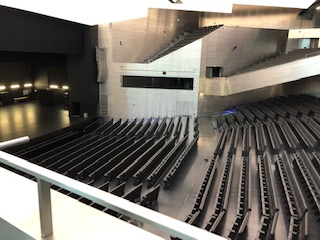
The main attraction of this building are the outstanding waterfalls that surround the outdoor square at the entrance to FIBES I. Once inside, the luminous marble Dome Hall gives way to all auditorium, rooms, restaurants, and halls.
FIBES I was designed to host large exhibitions and trade fairs, with three huge exhibition halls of 7,200 m2 each with no pillars at all and service boxes every 8 metres. These three halls are linked by a wide corridor to the conference centre building, where the 2 auditorium and breakout rooms are to be found.
FIBES ll is a more modern construction with floor to ceiling glass and hosts a state of the art Auditorium which can be divided into 2 or 3 simultaneous auditoria. If split into 3 the capacities are 1940, 340 & 400. There is a 620m2 stage and press rooms, green rooms, dressing rooms and additional spaces for organisers , storage etc attached to the Auditorium. There are large spaces totalling 1450 m2 for exhibitions and catering with access to outside terraces and then between the two centres there are 15 breakout rooms (12 – 140 delegates) and 3 further exhibition/catering areas and an outdoor exhibition area of 678m2, providing complete flexibility for large events.
There is extensive on-site parking and easy access to the airport and the city centre.
This Hacienda shows one of the best examples of rural architecture in Andalusia. It has one of the best collections horse-drawn carriages in the world and is a perfect location for gala dinners and other big events. The museum can host the drinks reception and then dinners of up to 1500 can be held in the adjacent space, the venue also has extensive gardens where drinks receptions can be held. the Mill Hall, an old oil mill that has now become a 430 M2 celebrations room with capacity for 300 people, or the Trade Hall (780 M2 room) with capacity for 550 people
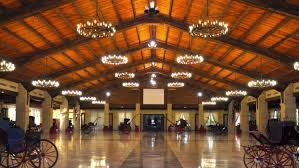
Other rooms for events or celebrations are the current Museum of Carriages, a room where the collection of more than two hundred vintage horse carriages (considered today as the best collection of old carriages in Europe), a perfect space to be used for reception glass, aperitif or cocktail, at the same time as cultural visit.
You also have the Old Carriage Museum Hall, a massive room of 3000 M2, without intermediate columns; ideal for gala dinners. Great also with small groups, since the unused space we decorate it with exhibition carriages, as if it were a dinner in a museum.
Around 1927 the Real Venta de Antequera was a traditional place for lodging breeders and bull fighters gatherings. During the Ibero-American Exhibition of 1929, it hosted the Pavillion of the Jerez lands, including spaces for bulls and a bullring enclave. Today it is a perfect and unique venue full of history and charm, to host MICE events. The was closed for a number of years until in 2013 Arrendaluza Slu took over the venue and it underwent a vast restoration.
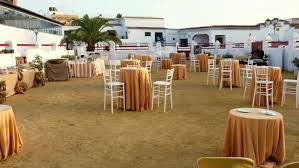
Outside space includes Corrales which can accommodate up to 2,000. It is a space that can offer great versatility for any event offering them the best service with a bullfighting flavour. It is currently where bullfighting classes are offered to practical amateurs, taught by maestro Dávila Miura. There are six salons which can accommodate 30 – 450 delegates.
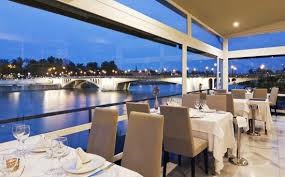
The Rio Grande Restaurant sits on the Banks of the River Guadalquivir in the Triana area of the city. The restaurant offers superb views across to the city. The restaurant serves both lunch and dinner and offers 4 event spaces inside and 3 terraces outside. Dinner can be served for up to 340 in the largest space and there is a terrace to serve cocktails for this number. The terraces are planted with orange or lemon trees and all have stunning view of the river and city.
The restaurant also hosts meetings in a couple of the spaces for up to 250 theatre style.